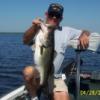I think that we need to clarify the fish that we are talking about. Largemouth bass are not deep water fish.
Habitat - Prefers clear, nonflowing waters with aquatic vegetation where food and cover are available. They occupy brackish to freshwater habitats, including upper estuaries, rivers, lakes, reservoirs and ponds. Also, they can tolerate a wide range of water clarities and bottom types, prefer water temperatures from 65 to 85 degrees, and are usually found at depths less than 20 feet.
Since I have been fishing for this critter a general rule was to fish the deepest shallow water you could find. That simply means: look for shallow water that is immediately adjacent to a deep water escape for the bass.
When I think of deep water bassin, I think spots or smallies and such, not largemouths. Of course, deep water is a relative thing. In a lake that has an average depth of 7 feet, a 12 foot hole would be deep.
I have yet to find a bait that they tire of. I have seen days when they won't hit spinner baits, or rattle traps, but that in no way means they have learned not to hit them.
Probably the most amazing thing of all that I have learned about largemouth bass is that they live by no rules. When they are supposed to be in two feet of water you find them in 9. When they are supposed to eat they don't, and when they shouldn't they do. Of course one of the reasons they are found to be opposite of our thought processes at times is because the thought process was ours, not theirs.
As it was wisely pointed out by several in this thread. K.I.S.S. - this isn't rocket science and when you try to make it so you are only confusing yourself. These fish are relatively easy to catch and it all has to do with finding them and then putting your bait in their face. Bass are members of the sunfish family. That makes them schoolers, not loners. Find one and you have found several. The more casts you make at them, the more you will catch.









